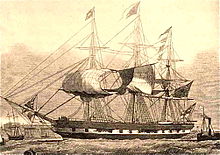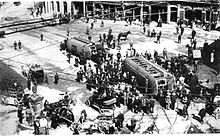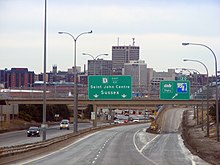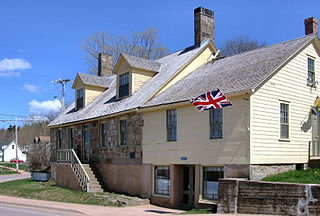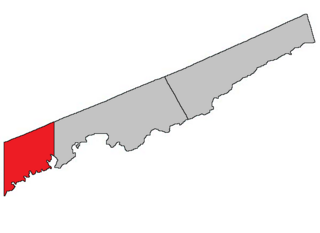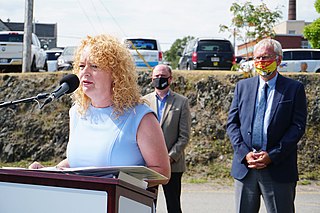Saint John | |
|---|---|
| The City of Saint John [lower-alpha 1] | |
Skyline of Uptown Saint John Germain Street row houses | |
| Nicknames: | |
| Motto(s): "O Fortunati Quorum Jam Moenia Surgunt" (Latin for, "O Fortunate Ones Whose Walls Are Now Rising." or "O Happy They, Whose Promised Walls Already Rise") | |
| Coordinates: 45°16′50″N66°04′34″W / 45.28056°N 66.07611°W | |
| Country | Canada |
| Province | New Brunswick |
| Historic countries | Kingdom of France Kingdom of Great Britain United Kingdom of Great Britain and Ireland |
| County | Saint John |
| Parish | City of Saint John [2] |
| Founded on | June 24, 1604 [3] |
| Major Settlement Started | 1783 [3] |
| Incorporation | May 18, 1785 |
| Named for | Saint John River |
| Government | |
| • Mayor | Donna Reardon |
| • Governing body | Saint John City Council |
| • MPs | Wayne Long |
| • MLAs | Trevor Holder, Gerry Lowe, Dorothy Shephard, Glen Savoie |
| Area | |
| • Land | 315.59 km2 (121.85 sq mi) |
| • Urban | 70.05 km2 (27.05 sq mi) |
| • Metro | 3,505.66 km2 (1,353.54 sq mi) |
| Highest elevation | 80.8 m (265.1 ft) |
| Lowest elevation | 0 m (0 ft) |
| Population (2021) | |
| • City | 69,895 [4] |
| • Density | 221.5/km2 (574/sq mi) |
| • Urban | 63,447 [5] |
| • Urban density | 905.8/km2 (2,346/sq mi) |
| • Metro | 130,613 [6] |
| • Metro density | 37.3/km2 (97/sq mi) |
| • City Pop 2016-2021 | |
| • Dwellings | 31,825 |
| Demonym(s) | Saint Johner, Saint-Jeannois(e), Johner (colloquial) |
| Time zone | UTC−04:00 (AST) |
| • Summer (DST) | UTC−03:00 (ADT) |
| Canadian Postal code | E2H, E2J, E2K, E2L, E2M, E2N, E2P, E2R, and E2S |
| Area code | 506 and 428 |
| Telephone exchanges | 202, 214, 333, 343, 557–8, 592, 608, 631–640, 642–654, 657–8, 663, 672, 674, 693–4, 696, 721, 977 |
| Highways | |
| NTS Map | 21G8 Saint John |
| GNBC Code | DAEGW [7] |
| GDP (Saint John CMA) | CA$6.4 billion (2016) [8] |
| GDP per capita (Saint John CMA) | CA$51,021 (2016) |
| Website | saintjohn |
Saint John is a seaport city located on the Bay of Fundy in the province of New Brunswick, Canada. It is Canada's oldest incorporated city, [lower-alpha 2] established by royal charter on May 18, 1785, during the reign of George III. [9] The port is Canada's third-largest by tonnage with a cargo base that includes dry and liquid bulk, break bulk, containers, and cruise. [10] The city was the most populous in New Brunswick until the 2016 census, when it was overtaken by Moncton. It is currently the second-largest city in the province, with a population of 69,895 over an area of 315.59 km2 (121.85 sq mi). [11]
Contents
- History
- Geography and climate
- Physical geography
- Architecture
- Parks and nature
- Neighbourhoods
- Climate
- Demographics
- Ethnicity
- Language
- Religion
- Economy
- Arts and culture
- Heavy industry
- Maritime industries
- Culture
- Dance, music, and theatre
- Film and television
- Museums
- National Historic sites
- Music
- Government and politics
- Government and court
- Politics
- Public safety
- Police and law enforcement
- Fire department
- Military
- Education
- Primary and secondary
- Post-secondary
- Public library system
- Labour
- Canada's first trade union
- The Saint John Street Railwaymen's strike and riot of 1914
- October 14, 1976: The Saint John General Strike
- The Irving Oil Refinery strike, 1994–1996
- Media
- Television
- Radio
- Transportation
- Air
- Highways
- Rail
- Port and ferries
- Public transit
- Sports
- Twin/sister cities
- See also
- Notes
- References
- External links
French explorer Samuel de Champlain landed at Saint John Harbour on June 24, 1604 (the feast of St. John the Baptist) and is where the Saint John River gets its name; the indigenous Mi'kmaq and Wolastoqiyik peoples called the river "Wolastoq". The Saint John area was an important area for trade and defence for Acadia during the French colonial era, and Fort La Tour, in the city's harbour, was a pivotal battleground during the Acadian Civil War. [12]
After more than a century of ownership disputes between the French and English over the land surrounding Saint John, the British government deported the Acadians in 1755 following the destruction of Fort Menagoueche and reconstructed as Fort Frederick. Following the pillaging and burning of Fort Frederick by American Privateers, Fort Howe was constructed across the river above the harbour in 1779. In 1785, the City of Saint John was established by uniting the two communities of Parr-town [13] and Carleton on either side of the harbour after the arrival of thousands of refugees from the newly founded United States who wished to remain British after the American Revolution. During the next century, immigration via Partridge Island, especially during the Great Famine, would fundamentally change the city's demographics and culture.












